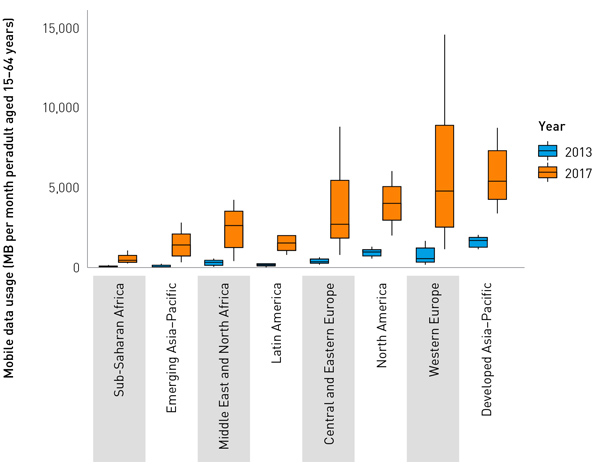5G opportunities in the 6GHz band
A much-cited ITU report from 2012 found that "First and foremost, the evidence is fairly conclusive about the contribution of broadband to GDP growth."1 The ITU published an updated report in 2018, which included an analysis of data for 139 countries between 2004 and 2017.2 Again, the report concluded that increased fixed and mobile broadband penetration yields economic growth and we are convinced that the internet will continue to be one of the most important contributors to economic growth and improved quality of life. 5G mobile network deployment is expected to boost broadband penetration.
Mobile data usage has grown substantially in recent years, but there is potential for further growth in many countries. In particular, we have identified five areas where the additional availability of mid-band spectrum will be beneficial for 5G networks.
- Mobile broadband and city-wide video consumption. Access to mid-band spectrum is especially useful for applications that involve city-wide video consumption such as audio-visual communications, in-vehicle entertainment, streaming of high-definition video content at popular locations, and enhanced mobile media experiences with high-quality video for augmented or virtual reality (AR/VR).
- Mobile networks for safe and smart cities. A number of high-bandwidth applications are being planned for safe and smart cities, such as video surveillance, real-time text translation, video-based sensor networks and applications for public safety and emergency response personnel.
- Mobile networks for Industry 4.0. Enterprises and businesses will benefit from access to networks that can support Industry 4.0 applications such as 5G-based machine control, vehicle-to-network (V2N) services, robot connectivity, "campus-wide" multimedia services, and AR overlays for remote maintenance or construction support.
- Fixed-wireless access (FWA). FWA based on 5G networks with sufficient spectrum can contribute to bridging the digital divide within and between countries and can increase the level of competition among operators and access technologies that provide high-speed internet services into homes and businesses.
- National connectivity objectives. Many countries and regions have ambitious broadband goals that might only be met by wireless networks as part of the solution. In both urban and rural areas, access to 5G infrastructure could assist with meeting connectivity policies in an economically viable manner (for example, where it is uneconomical or impractical to deploy fibre-based broadband networks).
Mobile data usage has increased sharply in recent years, although usage levels vary between countries and regions (see Figure 1). The horizontal black line inside each box represents median usage, the upper and lower range of the boxes show the 75th and 25th percentiles, and the vertical lines show the upper and lower range for the countries in each region.
Figure 1: Mobile data usage growth by region, 2013–2017

Source: Analysys Mason, EIU and World Bank
It is expected that data usage will continue to increase in many countries, although the variability between countries and regions will remain. Two important trends are likely to affect traffic growth and associated spectrum needs.
- The take-up of price plans with unlimited data usage ("unlimited pricing"). Mobile data pricing has important consequences for usage. For example, unlimited pricing has been in place for a long time in Finland, and usage in the country far exceeds any benchmarks in the region and is one of the highest in the world. If unlimited pricing continues in Finland, the annual growth rate in mobile data usage will be 30% and usage will be well above 150GB per capita per month in 2025. As other countries move towards unlimited usage plans, it is reasonable to expect that usage levels will increase in these countries too.
- Limited fixed-line availability in many countries and FWA. In many countries, a large share of households and businesses will not have access to high-speed (that is 100Mbit/s or more) fixed broadband coverage in the near future. Their connectivity needs could be met with high-capacity mobile networks. Assuming an annual growth rate of 30%, a household that uses 200GB of fixed broadband data today, would use around 1000GB per month in 2025. Household sizes vary around the world, but this would be an average of more than 250GB per month per user.
Timely availability of spectrum will continue to be important to support future developments of 5G. Compared with low- and high-frequency bands, mid-band spectrum can provide a better balance for meeting requirements for both coverage and capacity. This is probably why the recent World Radio Conference decided to include parts of the 6GHz band for study in relation to possible use for IMT.
1 R. Katz, The impact of broadband on the economy, ITU, 2012.
2 R. Katz and F. Callorda, The economic contribution of broadband, digitization and ICT regulation, ITU, 2018.
Downloads
Article (PDF)Authors

Harald Wium Lie
PartnerLatest Publications
Article
Policy makers must explore all possible levers to achieve gigabit connectivity ambitions
Report
AI for connectivity: how policy makers can help digitalisation
Tracker
Wireless decommissioning tracker 2H 2024

